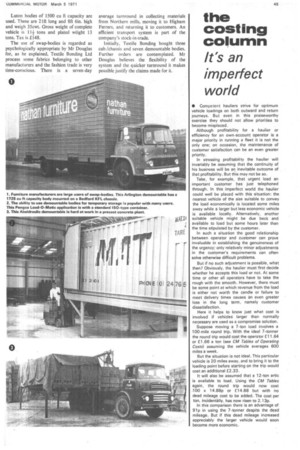the costing column
Page 47

If you've noticed an error in this article please click here to report it so we can fix it.
It's an
imperfect world
• Competent hauliers strive for optimum vehicle loadings on both outward and return journeys. But even in this praiseworthy exercise they should not allow priorities to become misplaced.
Although profitability for a haulier or efficiency for an own-account operator is a major priority in running a fleet it is not the only one; on occasion, the maintenance of customer satisfaction can be an even greater priority.
In stressing profitability the haulier will invariably be assuming that the continuity of his business will be an inevitable outcome of that profitability. But this may not be so.
Take, for example, that urgent load an important customer has just telephoned through. In this imperfect world the haulier could well be placed with this situation: the nearest vehicle of the size suitable to convey the load economically is located some miles away while a larger but less economic vehicle is available locally. Alternatively, another suitable vehicle might be due back and available to load but some hours later than the time stipulated by the customer.
In such a situation the good relationship between operator and customer can prove invaluable in establishing the genuineness of the urgency; only relatively minor adjustments in the customer's requirements can often solve otherwise difficult problems.
But if no such adjustment is possible, what then? Obviously, the haulier must first decide whether he accepts this load or not. At some time or other all operators have to take the rough with the smooth. However, there must be some point at which revenue from the load is either not worth the candle or failure to meet delivery times causes an even greater loss in the long term, namely customer dissatisfaction.
Here it helps to know just what cost is involved if vehicles larger than normally necessary are used as a compromise solution.
Suppose moving a 7-ton load involves a 100-mile round trip. With the ideal 7-tonner the round trip would cost the operator £11.64 or £1.66 a ton (see CM Tables of Operating Costs) assuming the vehicle averages 600 miles a week.
But the situation is not ideal. This particular vehicle is 20 miles away, and to bring it to the loading point before starting on the trip would cost an additional £2.33.
It will also be assumed that a 12-ton artic•is available to load. Using the CM Tables
again, the round trip would nOw cost .100 x 14.88p or £14.88 but with no dead mileage cost to be added. The cost per ton, incidentally, has now risen to 2.13p.
In this comparison there is an advantage of 91p in using the 7-tonner despite the dead mileage. But if this dead mileage increased appreciably the larger vehicle would soon become more economic.




































































































